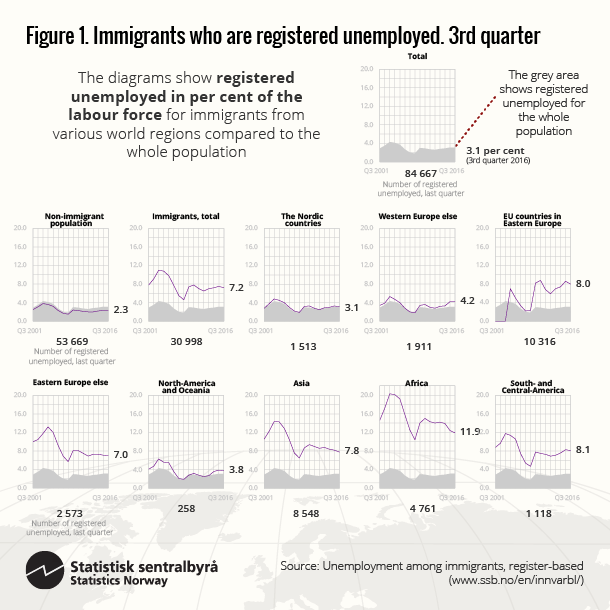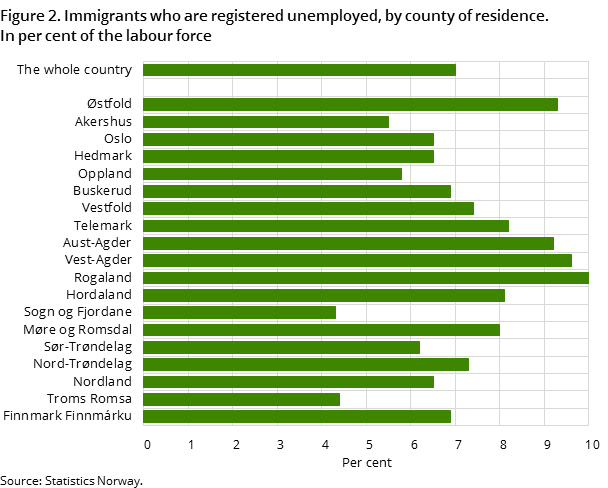Content
Published:
This is an archived release.
Fewer unemployed, but more on labour market schemes
Registered unemployment among immigrants decreased from 7.5 per cent in August 2015 to 7.2 per cent in August 2016, while the unemployment rate was stable at 2.3 per cent within the rest of the population. In the whole population, the unemployment rate was 3.1 per cent in August 2016.
| 3rd quarter 2016 | Change last twelve months | |||
|---|---|---|---|---|
| Absolute figures | Per cent | 3rd quarter 2015 - 3rd quarter 2016 | ||
| Absolute figures | Percentage points | |||
| 1Non-residents included. | ||||
| 2Turkey is included. | ||||
| Registered unemployed, total | 84 667 | 3.1 | -34 | 0.0 |
| Non-immigrant population1 | 53 669 | 2.3 | 158 | 0.0 |
| Immigrants, total | 30 998 | 7.2 | -192 | -0.3 |
| The Nordic countries | 1 513 | 3.1 | -99 | -0.2 |
| Western Europe else | 1 911 | 4.2 | 80 | 0.0 |
| EU countries in Eastern Europe | 10 316 | 8.0 | -310 | -0.6 |
| Eastern Europe else | 2 573 | 7.0 | 43 | -0.1 |
| North-America and Oceania | 258 | 3.8 | -1 | -0.1 |
| Asia2 | 8 548 | 7.8 | -88 | -0.4 |
| Africa | 4 761 | 11.9 | 182 | -0.5 |
| South- and Central-Amerika | 1 118 | 8.1 | 1 | -0.2 |
Almost 31 000 immigrants were registered as unemployed by the end of August this year, which is the reference time of the 3rd quarter. These people constituted 36.6 per cent of the registered unemployed in total.
There was a decline in the unemployment rate within all of the immigrant groups, but with some variations. Immigrants from the EU countries in the east had the strongest fall at 0.6 percentage points. Immigrants from Africa and Asia also had a decrease, of 0.5 and 0.4 percentage points respectively. The remaining groups, however, had rather marginal decreases.
Increase among participants on labour market schemes
Conversely, the number of immigrants who participated on labour market schemes went up by 2 264 from August 2015 to August 2016, which constituted a growth of 56.7 per cent within this participant group. The participant rate also increased. When the rate of unemployed and participants on labour market schemes are added together (i.e. the gross unemployment rate as a percentage of the labour force), there was a slight growth at 0.2 percentage points among immigrants during the last year. Also within the rest of the population the number of participants went up (by 58.6 per cent), and the gross unemployment rate increased slightly by 0.1 percentage points.
African immigrants still have the highest unemployment rate
Despite some decrease, immigrants from Africa still have the highest unemployment rate, at 11.9 per cent in the 3rd quarter, which is due to the large percentage of refugees within this group. Next were immigrants from Latin America and the EU countries in Eastern Europe at about 8 per cent within each group. Immigrants from Asia had a rate of 7.8 per cent, while those from Eastern Europe outside the EU had 7 per cent registered unemployed, which is slightly below the immigrant average. As usual, the remaining groups had rates far below the immigrant average: Western Europe (4.2 per cent), North America and Oceania (3.8 per cent) and the Nordic countries (3.1 per cent).
Higher unemployment rate among immigrant women
Within the immigrant group, women have a higher unemployment rate than men, with 7.5 per cent versus 7.0 per cent. Within the rest or the population we can observe the opposite pattern, 1.9 per cent among women and 2.6 per cent among men.
fig-2016-11-16-01-en; Immigrants who are registered as unemployed as a percentage of the labour force by county of residence. At the end of August 2016.
Lower unemployment among Norwegian-born to immigrant parents than immigrants
Norwegian-born to immigrant parents is still a rather small group of unemployed persons. This group constituted 1 194 registered unemployed persons in the 3rd quarter of 2016. A large share of this group is aged 15-29 years, and the unemployment rate within this age group was 4.3 per cent. Immigrants and the rest of the population at the same age had 7.6 and 3 per cent unemployed respectively.
Both Norwegian-born to immigrant parents and the rest of the population aged 15-29 years had a decrease of 0.4 percentage points, while there was a decline of 0.3 percentage points among immigrants.
Additional information
The unemployment figures are based on the Norwegian Labour and Welfare Organisation’s register of jobseekers and are calculated as a share of the labour force, which is the sum of employed persons and registered unemployed persons, i.e. people offering their labour on the labour market.
Contact
-
Statistics Norway's Information Centre
E-mail: informasjon@ssb.no
tel.: (+47) 21 09 46 42


